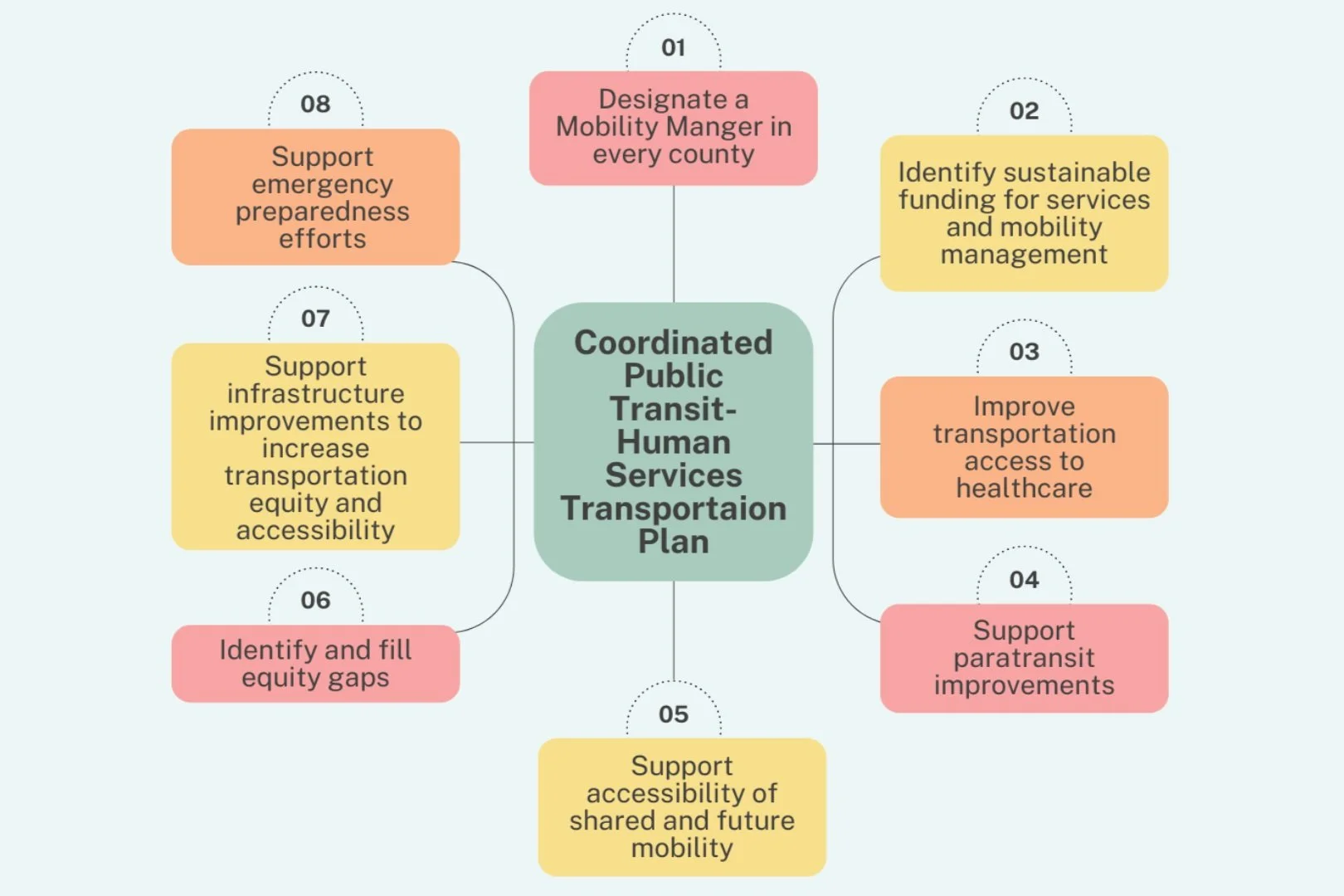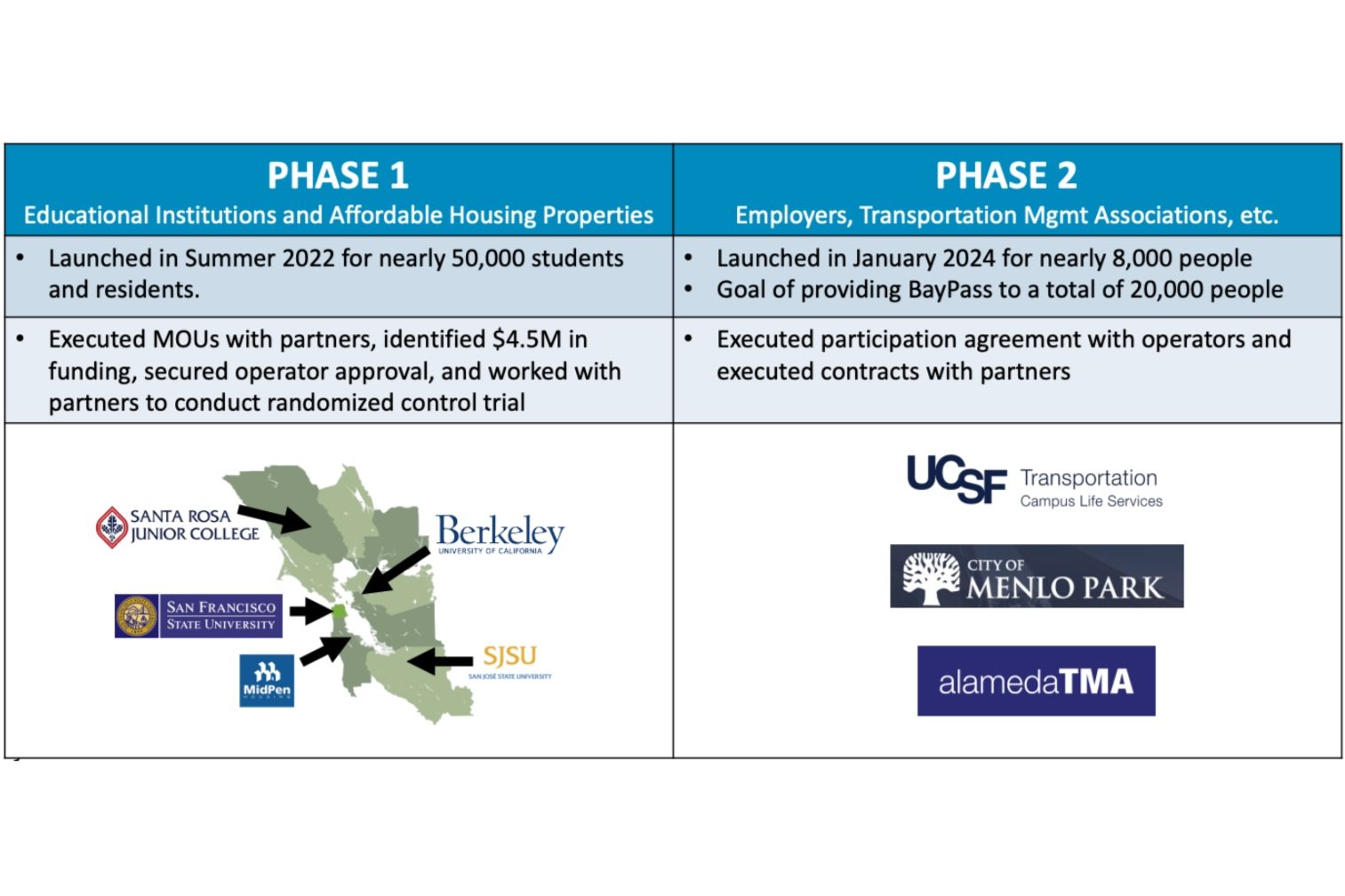On May 11th, Silicon Valley Bicycle Coalition hosted a bike ride and poster session on El Camino Real to highlight bike lanes, pedestrian improvements, transit speed, and affordable housing projects and plans in Santa Clara and San Mateo Counties. The poster session showed only a fraction of the many changes happening along the corridor, which is evolving according to a vision created nearly two decades ago to transform an auto-oriented corridor with more sustainable, multi-modal transportation and with walkable, mixed use development.
Read MoreMTC is set to release a draft of the Coordinated Public Transit-Human Services Transportation Plan, outlining the Bay Area’s near-term transportation blueprint for people with disabilities, older adults, and low-income populations. This plan addresses the challenges with funding gaps, accessible transit infrastructure, and reinforces other near-term regional plans.
Read MoreHigher frequencies, faster trip times, expanding coverage, and easier transfers are needed to increase transit availability. These priorities were the focus of the Transit Transformation Task Force’s (TTTF) third meeting in San Diego on April 15th. The TTTF, a major effort to define reforms and funding needed to transform transit in California, is focused on developing benchmarks for service levels, funding recommendations, and governance reforms needed to grow statewide transit ridership.
Read MoreLast week, the critically-important Connect Bay Area legislation (SB 1031 Wiener/Wahab), authorizing a regional transportation funding measure, was amended with changes responding to concerns from transit agencies and other stakeholders. The amendments refine the funding formula to ensure funding for all counties including those that aren’t facing imminent operating funding gaps; clean up language about a consolidation study; set guardrails on MTC’s authority to coordinate service.
Read MoreWe encourage organizations to show their support for SB 1031, the Connect Bay Area Act, a critical bill for the future of Bay Area transit! Use the template in this blog post to submit your support letter to the Senate Transportation Committee and Senate Revenue and Taxation Committee before 12pm on April 17th. Introduced by Senators Scott Wiener and Aisha Wahab, SB 1031 authorizes a Bay Area transportation funding measure that is expected to raise between $1-2 billion annually and with reforms to deepen transit integration, study the consolidation of public transit agencies, and more. Please also spread the word to other groups
Read MoreSenators Scott Wiener and Aisha Wahab have introduced SB1031, or the Connect Bay Area Act, authorizing a Bay Area transportation funding measure with reforms to deepen transit integration, study the consolidation of public transit agencies, and more. Seamless Bay Area strongly supports this bill. It’s a once-in-a-generation opportunity to transform Bay Area transit with funding for more frequent, fast, coordinated service. The bill’s policy reforms will help guarantee that new and existing funding go further, delivering convenient, well-coordinated service and making sure our buses and trains are faster, safer, and more reliable.
Read MoreExpanding public transportation will play a key role in reaching California’s 2045 carbon neutrality mandate and case studies of Canadian cities showcase just how California can boost ridership. These subject areas were the focus of the Transit Transformation Task Force’s second meeting on February 29th in Sacramento. The TTTF is tasked with developing policy and funding recommendations to grow transit ridership statewide, with a focus on supporting the state’s ambitious climate goals.
Read MoreSeamless Bay Area joins transit and environmental advocacy organizations and labor groups across the country in support of H.R. 7039 - the Stronger Communities Through Better Transit Act, a recent bill announced by Congressman Hank Johnson of Georgia, that could transform transit nationwide with additional funding. If passed, the bill will provide $20 billion in annual transit operations funding over four years ($80 billion). Read more about the bill, and then check below if your congressperson has cosponsored this important bill.
Read MoreThe Alameda Transportation Management Association has joined the second phase of the Clipper Bay Pass pilot, which is serving employers and transportation management associations. Alameda’s TMAs serve 900 residents and 600 employees in the City of Alameda. Before the Bay Pass was available, ATMA provided EZPasses giving access to AC Transit. Now, residents and workers also have access to BART, ferries, and other Bay Area transit services.
Read MoreIntegrating the Bay Area’s 27 transit agencies’ schedules and fares, oversight of spending by experts, and streamlining systems to improve efficiency are supported by a strong majority of voters, and may be key to winning a future regional ballot measure focused on improving transportation, according to a new poll from Seamless Bay Area and the Beneficial State Foundation. The results provide important insights on public attitudes around transportation as elected officials and public transit agencies seek to identify sustainable long-term funding for Bay Area public transit to prevent cuts and fund improvements.
Read MoreRiders are beginning to see real progress on many of the long-discussed initiatives to integrate the region's transit systems, from fare integration to wayfinding to transit priority - and more. It’s important to recognize how far we’ve come - seamless transit is finally taking shape in the Bay Area thanks to riders speaking up, elected officials championing integration, and greater than ever attention from Transit General Managers (Transit GMs) and the Metropolitan Transportation Commission (MTC). We summarize the impact and timeline of some important collaborative efforts in this post.
Read MoreOn January 24, the Metropolitan Transportation Commission voted to pursue authorizing legislation in 2024 for a regional transportation funding measure that could go on the ballot as soon as 2026, and could be used in future years. The proposal would authorize MTC to put a measure on the ballot with goals for transit transformation, safe streets, connectivity, and climate resilience. MTC’s proposal would defer a recommendation about how much to allocate per category, allowing for stakeholder input before a measure goes on the ballot.
Read MoreThe final report from the Bay Area study delegation tour of Switzerland was just released highlighting key takeaways and applicable lessons for the Bay Area regarding fare integration, infrastructure planning, and timetable coordination, and other topics. General Managers welcomed the report’s findings and expressed support in applying Swiss practices to current initiatives and continuing to pursue knowledge exchange opportunities.
Read MoreEast Bay Paratransit is set to join MTC’s One-Seat Ride Pilot Program, creating a more seamless experience for riders taking trips that cross agency service boundaries and with potential cost savings for paratransit service providers. The One-Seat Ride program between four other East Bay agencies has increased on-time performance, decreased average dwell times, and decreased “no show” and cancellation rates. AC Transit plans to submit an application in April, around the time when MTC will open its call for pilot proposals.
Read MoreMTC Commissioners discussed proposed policies to increase voter confidence and improve agency accountability in the context of a regional transportation funding measure at 3 meetings in December. Staff recommended the authorizing legislation strengthen MTC’s role as a transit network manager to accelerate the region’s “Transformation Action Plan” initiatives for integrated fares, schedules, wayfinding and other system coordination improving rider experience. MTC is looking to sponsor enabling legislation in 2024 that would authorize placing a measure on the ballot in up to nine counties as early as in 2026.
Read MoreSingapore is a transit mecca that both exemplifies well-known transit best practices and challenges oft-held assumptions of how transit ‘should’ work. As I’ve been taking transit in the city-state of 5.5 million over the past week (while visiting family who live in Singapore), I’ve found a lot to be inspired by. Of course I am aware that Singapore and cities in California have many differences - but now more than ever California needs to be looking abroad at successful practices in other parts of the world as we seek to transform transit. Singapore offers plenty of lessons.
Read MoreThe SB125 Transit Transformation Task Force – charged by the state legislature with studying the costs to operate and maintain public transportation over the next ten years and making recommendations regarding how to improve mobility and increase ridership on transit – hosted their inaugural meeting on December 19th. The task force includes 25 members, with representation from transit agencies, labor, business, academics, and nonprofits (including Seamless Bay Area), as well as key staffers from the state administration and legislature.
Read MoreIn November, Monterey Salinas Transit announced that veterans can access their transit discounts by paying with a contactless credit or debit card. Seniors in the Monterey-Salinas area gained the ability in September of 2022. Seniors in Santa Barbara gained access in 2023. These developments open up the possibility that transit riders in the Bay Area might be able to access discounts they’re eligible for while paying with a credit or debit card, sometime after the launch of the next-generation Clipper system in the Fall of 2024.


















